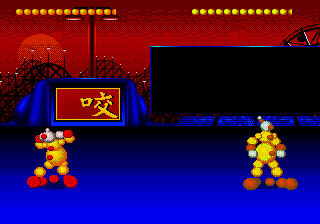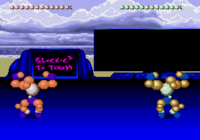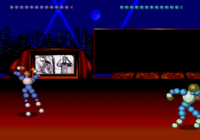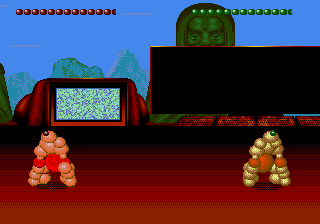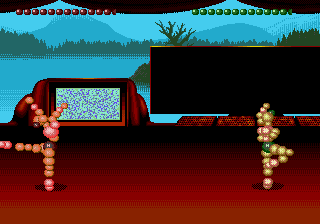Ballz 3D
From Sega Retro
| Ballz 3D | |||||||||||||||||||||||||||||||||||||||||||||||||||||||
|---|---|---|---|---|---|---|---|---|---|---|---|---|---|---|---|---|---|---|---|---|---|---|---|---|---|---|---|---|---|---|---|---|---|---|---|---|---|---|---|---|---|---|---|---|---|---|---|---|---|---|---|---|---|---|---|
| System(s): Sega Mega Drive | |||||||||||||||||||||||||||||||||||||||||||||||||||||||
| Publisher: Accolade | |||||||||||||||||||||||||||||||||||||||||||||||||||||||
| Developer: PF Magic | |||||||||||||||||||||||||||||||||||||||||||||||||||||||
| Supporting companies: Futurescape Productions (some programming[1]) | |||||||||||||||||||||||||||||||||||||||||||||||||||||||
| Distributor: SF Interactive Media (SE rental), Sega-Ozisoft (AU), Tec Toy (BR) | |||||||||||||||||||||||||||||||||||||||||||||||||||||||
| Sound driver: GEMS | |||||||||||||||||||||||||||||||||||||||||||||||||||||||
| Genre: Action | |||||||||||||||||||||||||||||||||||||||||||||||||||||||
| Number of players: 1-2 | |||||||||||||||||||||||||||||||||||||||||||||||||||||||
| |||||||||||||||||||||||||||||||||||||||||||||||||||||||
|
Ballz 3D: Fighting at its Ballziest, known in Europe as Ballz 3D: The Battle of the Balls, is a Sega Mega Drive fighting game developed by PF Magic and published by Accolade. Released in 1994 to positive reviews, the game is most notable for constructing its characters entirely with spheres to simulate three-dimensional animation, similar to Vectorman.
Contents
Gameplay
The game is a fighting game where each character is composed completely of colored spheres. Since spheres look the same at any angle, this technique gives the game the appearance of depth and rotation in a three-dimensional space without requiring any specialized hardware. Combat takes place in three-dimensional arenas, with each fighter able to move in any direction on a two-dimensional plane. Each fighter has a health bar, indicated by a string of balls in the top corners of the screen. Rounds last for 99 seconds; when time runs out, both fighters start rapidly losing health, allowing one fighter to finish the other off or potentially ending in a draw. Scoreboard screens in the background of the arenas show pictures and commentary based on the fight.
Fighters move with ![]() or
or ![]() and strafe around the arena with
and strafe around the arena with ![]() or
or ![]() . They jump
. They jump ![]() , with the height of the jump controlled by holding the button longer. They can punch with
, with the height of the jump controlled by holding the button longer. They can punch with ![]() and kick with
and kick with ![]() . Kicks are generally slower than punches but do more damage. They can do a low attack by holding
. Kicks are generally slower than punches but do more damage. They can do a low attack by holding ![]() while simultaneously pressing the
while simultaneously pressing the ![]() or
or ![]() , a lunging attack by holding the D-Pad toward the opponent and pressing
, a lunging attack by holding the D-Pad toward the opponent and pressing ![]() or
or ![]() , or a short attack by holding the D-Pad away the opponent and pressing
, or a short attack by holding the D-Pad away the opponent and pressing ![]() or
or ![]() . Fighters also have several special moves exclusive to them. They can block attacks by holding the D-Pad away from the opponent. They can block high or low using the diagonals. Some special moves, such as explosions or cyclones, still cause damage when blocked. If knocked down, they can roll away by pressing
. Fighters also have several special moves exclusive to them. They can block attacks by holding the D-Pad away from the opponent. They can block high or low using the diagonals. Some special moves, such as explosions or cyclones, still cause damage when blocked. If knocked down, they can roll away by pressing ![]() or
or ![]() while simultaneously pressing the punch button.
while simultaneously pressing the punch button.
When both fighters are close to each other, one fighter can grab the other by pressing ![]() . Pressing
. Pressing ![]()
![]()
![]()
![]()
![]() rapidly can break the grapple, with whichever player presses it faster winning the struggle and delivering a counterattack. Alternatively, a fighter can perform a grab attack by pressing
rapidly can break the grapple, with whichever player presses it faster winning the struggle and delivering a counterattack. Alternatively, a fighter can perform a grab attack by pressing ![]() when near the opponent.
when near the opponent.
Fighters become dizzy when they are hit three times in a row without blocking. This leaves them vulnerable as they are unable to move or attack, but it can be escaped by pressing ![]()
![]()
![]()
![]()
![]() rapidly. When low on life, fighters become tired and change to a fatigued stance. They can beg for additional life by pressing
rapidly. When low on life, fighters become tired and change to a fatigued stance. They can beg for additional life by pressing ![]()
![]()
![]() quickly. When the opponent is fatigued, a fighter can perform a finishing move by pressing
quickly. When the opponent is fatigued, a fighter can perform a finishing move by pressing ![]()
![]()
![]() to instantly finish the opponent. Fighters break apart into their constituent balls when defeated.
to instantly finish the opponent. Fighters break apart into their constituent balls when defeated.
Fighters can perform a taunt by pressing ![]() +
+![]() +
+![]() , which leaves them vulnerable for attack but increases the damage of the next attack. Multiple taunts can be performed to further increase the damage of the next move.
, which leaves them vulnerable for attack but increases the damage of the next attack. Multiple taunts can be performed to further increase the damage of the next move.
Modes
In the single-player mode, the player faces a series of matches to the best of three rounds. There are 13 opponents, with a fight against a sub-boss every three matches to earn a colored belt (as in martial arts). There are four belts (red, green, blue, and black), with each one increasing the damage that the fighter inflicts. Part of the fighter's model changes color to indicate a promotion. After defeating the fourth sub-boss in the twelfth match and attaining a black belt, the player progresses to a final fight against the Jester. There is a difficulty setting, which changes the number of times the game can be continued if the player loses a match (6 for Easy, 3 for Medium, or 1 for Hard).
There is also a two-player versus mode where players choose any character and fight a match to the best of three rounds. There are options to change the number of rounds needed to win a match (1-out-of-1, 3-out-of-5, 6-out-of-11, or 11-out-of-21) and the handicap for each player (none, red, green, blue, or black, with each color doing progressively more damage). The game shows an instant replay after the last round of the match.
Characters
Note: Move lists assume that the character is facing right. When facing left, ![]() and
and ![]() should be reversed.
should be reversed.
Playable
All eight playable fighters are faced in the single-player game, and they are all playable in either mode.
Bosses
Four sub-bosses are fought in the single-player game, then the Jester is fought as the final boss. The bosses are not playable in either mode.
| Guggler | |
|---|---|
| The first sub-boss. An ostrich. Defeating her wins the red belt. | |
| Bounder | |
| The second sub-boss. A kangaroo who wears boxing gloves. Defeating him wins the green belt. | |
| T-Wrecks | |
| The third sub-boss. A gigantic dinosaur. Defeating him wins the blue belt. | |
| Lamprey | |
| The fourth sub-boss. A mystical genie who can transform into different forms. Defeating him wins the black belt. | |
| El Ballz | |
| One of the transformations of Lamprey. A bull. | |
| Byte Viper | |
| One of the transformations of Lamprey. A viper. | |
| Spike | |
| One of the transformations of Lamprey. A scorpion. | |
| The Jester | |
| The final boss. A jester and the one who challenged all of the fighters to a tournament. |
Morphing
Every fighter has the ability to morph into another fighter in the middle of a match. The button combinations are the same regardless of which fighter is being played. The morph lasts until the end of the match or until the player morphs into a different fighter.
| Name | Command | Description |
| Boomer | ||
| Bruiser | ||
| Crusher | ||
| Divine | ||
| Kronk | ||
| Tsunami | ||
| Turbo | ||
| Yoko |
Stages
Every character has their own stage when faced in the single-player mode, except the bosses, who all share the same stage. In the two-player mode, the game uses the stage for the player with the most wins (or the first player, if both players are tied).
History
Development
The Mega Drive version was originally intended for use with the Edge 16, a modem system for multiplayer gaming that was eventually cancelled.
Versions
Ballz 3D was released simultaneously on the Mega Drive and Super NES, and while the two share similar gameplay, the visuals differ significantly.
In addition to making use of the wider colour palette, the Super NES version of Ballz 3D utilises the DSP-1B maths co-processor, allowing for more advanced "mode 7" scaling and rotation than many other SNES titles. This subsequently means the floor in the SNES version of Ballz 3D is textured, while backgrounds are able to make use of alpha transparency, neither of which are supported by standard Mega Drive hardware. The Mega Drive version instead uses an untextured surface for its floor, comprised of a single gradient of colour (though interestingly, the later 3DO Directors Cut version also opts for a similar style).
The Mega Drive version runs with a higher screen resolution and at a higher frame rate than its Super NES counterpart.
Production credits
- Game Design and Concept: Keith Kirby
- Producer: Ted Barnett
- Lead Programmer: Keith Kirby
- Lead Animator: Frank M. Saxon Jr.
- Main Character Animations: Adam Frank, Will Friedewald, Kyle Kirby, Dan Lopez, Lon Richter
- Character Design: Adam Frank, Will Friedewald, Kyle Kirby, Bill Maher
- Creative Producer: Curtis Norris
- Shell Programmers: Larry Garner, Matthew Hubbard, Rich Young
- Shell Art: Connie Braat, Chris Donovan, Charles Hacskaylo, Richard Hermanson
- Instant Replay Programmer: Matthew Hubbard
- Arena and Background Art: Chris Donovan
- Intro and Belt Ceremony Art: Connie Braat, Richard Hermanson
- Music and Sound Effects: Neuromantic Productions, Mark Miller, Jason Scher
- Voice Casting and Coaching: SmarTalk, Beth J. Kaufman
- Voices: Colin Hussey, Heather McClure, Shawn Owens
- Edge 16 Support Programming: Lee Powell
- Manual Text - Jester's Worlds: Flint Dille, Buzz Dixon
- Lead Tester: Mike Palser
- On-Site Testers: Travis Boatman, Stefan M. Nelson
- Scoreboard Text: Flint Dille, Reed Kirk Rahlmann
- Ballz slang written and created by: Reed Kirk Rahlmann
- TV Art: Connie Braat, Chris Donovan, Richard Hermanson, Dan Lopez, Rick Lucy
- Executive Producers: Rob Fulop, John Scull
- Technical Director: David Feldman
- Chief Financial Officer: Jim Guerard
- Marketing Coordinator: Brooke Boynton
- Special Thanks to: Fox Hughes, Paul Wilkerson, Brenda Ross, Barbara Hryniewicz, Thena MacArthur, Gay Littlepage, Futurescape Productions, Studio Brazil
- Producer: Todd Thorson
- Product Marketing Manager: Karen Safran
- Testers: Alex V. Cabal, Randall Hauser, Ty Johnson, Chris Nash
- Marketing: Larry Wiesler, Melinda Mongelluzzo, Shirley Sellers
Magazine articles
- Main article: Ballz 3D/Magazine articles.
Promotional material
also published in:
- Electronic Gaming Monthly (US) #65: "December 1994" (1994-xx-xx)[11]
Physical scans
| Sega Retro Average | ||||||||||||||||||||||||||||||||||||||||||||||||||||||||||||||||||||||||||||||||||||||||||||||||||||||||||||||||||||||||||||||||||||||||||||||||
|---|---|---|---|---|---|---|---|---|---|---|---|---|---|---|---|---|---|---|---|---|---|---|---|---|---|---|---|---|---|---|---|---|---|---|---|---|---|---|---|---|---|---|---|---|---|---|---|---|---|---|---|---|---|---|---|---|---|---|---|---|---|---|---|---|---|---|---|---|---|---|---|---|---|---|---|---|---|---|---|---|---|---|---|---|---|---|---|---|---|---|---|---|---|---|---|---|---|---|---|---|---|---|---|---|---|---|---|---|---|---|---|---|---|---|---|---|---|---|---|---|---|---|---|---|---|---|---|---|---|---|---|---|---|---|---|---|---|---|---|---|---|---|---|---|
|
| 78 | |
|---|---|
| Based on 28 reviews | |
| Mega Drive, PT |
|---|
|
| Mega Drive, SE (rental; SF) |
|---|
Technical information
- Main article: Ballz 3D/Technical information.
References
- ↑ 1.0 1.1 File:Ballz MD US manual.pdf, page 19
- ↑ Electronic Gaming Monthly, "September 1994" (US; 1994-xx-xx), page 99
- ↑ 3.0 3.1 Game Players, "Vol. 7 No. 9 September 1994" (US; 1994-0x-xx), page 80
- ↑ 4.0 4.1 4.2 Mean Machines Sega, "October 1994" (UK; 1994-08-xx), page 80
- ↑ 5.0 5.1 Mega, "September 1994" (UK; 1994-08-18), page 44
- ↑ Computer Trade Weekly, "" (UK; 1994-09-19), page 21
- ↑ File:DailyExpress UK 1994-09-23 46.jpg
- ↑ 8.0 8.1 Computer & Video Games, "October 1994" (UK; 1994-09-15), page 91
- ↑ Sega Megazone, "January 1995" (AU; 199x-xx-xx), page 32
- ↑ GamePro, "November 1994" (US; 1994-xx-xx), page 190
- ↑ Electronic Gaming Monthly, "December 1994" (US; 1994-xx-xx), page 136
- ↑ GamePro, "January 1995" (US; 199x-xx-xx), page 19
- ↑ 1700 igr dlya Sega, "" (RU; 2001-xx-xx), page 24
- ↑ Consoles +, "Septembre 1994" (FR; 1994-0x-xx), page 100
- ↑ Electronic Games (1992-1995), "September 1994" (US; 1994-0x-xx), page 72
- ↑ Electronic Gaming Monthly, "October 1994" (US; 1994-xx-xx), page 38
- ↑ GamePro, "September 1994" (US; 1994-xx-xx), page 58
- ↑ Gamer, "Dekémvrios 1994" (GR; 1994-xx-xx), page 1
- ↑ GamesMaster, "September 1994" (UK; 1994-08-25), page 46
- ↑ GamesMaster (UK) "Series 4, episode 1" (1994-09-20, 24:00) (+8:25)
- ↑ Games World: The Magazine, "October 1994" (UK; 1994-08-25), page 12
- ↑ Game Informer, "September/October 1994" (US; 1994-0x-xx), page 24
- ↑ LeveL, "Leden 1995" (CZ; 1995-01-24), page 41
- ↑ Mega Force, "Septembre 1994" (FR; 1994-0x-xx), page 110
- ↑ Mega Fun, "11/94" (DE; 1994-10-19), page 77
- ↑ Player One, "Septembre 1994" (FR; 1994-0x-xx), page 100
- ↑ Play Time, "11/94" (DE; 1994-10-05), page 106
- ↑ Power Up!, "Saturday, October 01, 1994" (UK; 1994-10-01), page 1
- ↑ Sega Magazine, "October 1994" (UK; 1994-09-15), page 88
- ↑ Sega Power, "October 1994" (UK; 1994-09-01), page 54
- ↑ Sega Pro, "October 1994" (UK; 1994-09-08), page 50
- ↑ Sonic the Comic, "November 25th 1994" (UK; 1994-11-12), page 10
- ↑ Todo Sega, "Octubre 1994" (ES; 1994-xx-xx), page 60
- ↑ Tricks 16 bit, "Tricks Sega Gold 800 igr" (RU; 1998-03-20), page 18
- ↑ Video Games, "10/94" (DE; 1994-09-28), page 98
- ↑ VideoGames, "January 1995" (US; 199x-xx-xx), page 62
| Ballz 3D | |
|---|---|
|
Main page | Comparisons | Hidden content | Magazine articles | Video coverage | Reception | Region coding | Technical information | Bootlegs
Prototypes: 1994-06
| |
- 1-2 player games
- US Mega Drive games
- All US games
- US Sega Channel games
- EU Mega Drive games
- All EU games
- EU Sega Channel games
- PT Mega Drive games
- All PT games
- UK Mega Drive games
- All UK games
- SE Mega Drive games
- All SE games
- AU Mega Drive games
- All AU games
- BR Mega Drive games
- All BR games
- SA Mega Drive games
- All SA games
- SA Sega Channel games
- Mega Drive games
- 1994 Mega Drive games
- All 1994 games
- Mega Drive action games
- All action games
- All games
- Ballz 3D
- Mega Drive fighting games






